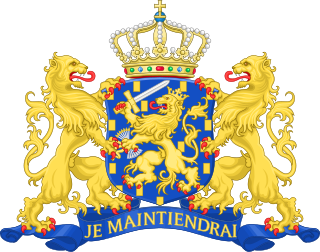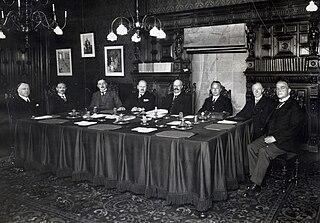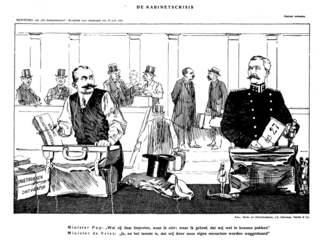
Pieter Wilhelm Adrianus Cort van der Linden was a Dutch politician who served as Prime Minister of the Netherlands from August 1913 to September 1918.

General elections were held in the Netherlands on 5 July 1922. They were the first elections held under universal suffrage, which became reality after the acceptance of a proposal by Henri Marchant in 1919 that gave women full voting rights. Almost all major parties had a woman elected. The number of female representatives increased from one to seven. Only the Anti-Revolutionary Party principally excluded women from the House of Representatives. Another amendment to the electoral law increased the electoral threshold from 0.5% to 0.75%, after six parties had won seats with less than 0.75% of the vote in the previous elections.

The Christian Historical Union was a Protestant Christian democratic political party in the Netherlands. The CHU is one of the predecessors of the Christian Democratic Appeal (CDA), into which it merged in September 1980.

JonkheerCharles Joseph Marie Ruijs de Beerenbrouck was a Dutch politician of the Roman Catholic State Party (RKSP). He served as Chairman of the Council of Ministers from 9 September 1918 until 4 August 1925 and from 10 August 1929 until 26 May 1933.

The Roman Catholic State Party was a Catholic Christian democratic political party in the Netherlands. The party was founded in 1926 as a continuation of the General League of Roman Catholic Electoral Associations. During its entire existence, the party was in government. In 1945 the party became the Catholic People's Party (KVP).

The General League of Roman Catholic Electoral Associations, informally called the General League, was a Catholic political party in the Netherlands. It existed from 1904 to 1926, when it was succeeded by the Roman Catholic State Party. It is one of the ancestors of today's Christian Democratic Appeal.

Petrus Josephus Mattheus "Piet" Aalberse Sr. was a Dutch politician of the General League of Roman Catholic Caucuses, later the Roman Catholic State Party (RKSP) and later co-founder of the Catholic People's Party (KVP) and jurist. He was granted the honorary title of Minister of State on 31 December 1934.
The Coalition is a historic coalition between three confessional parties of Netherlands - the Christian Historical Union, Anti-Revolutionary Party and Roman Catholic State Party. They were united in their common struggle for equal financing for religious schools. They were opposed to the Concentration. The Coalition governed between 1888 and 1891, led by Æneas Mackay, 1901 and 1905 led by Abraham Kuyper, 1908 and 1913 led by Theo Heemskerk and between 1918 and 1940 led by several politicians, Hendrikus Colijn, Dirk Jan de Geer and Charles Ruijs de Beerenbrouck.
The Red Week was an unsuccessful attempt to start a socialist revolution in the Netherlands in early November 1918. The revolutionary attempt, which lasted nearly a week, from 9 to 14 November, which is why it is known as the Red Week. It is also known as "Troelstra's mistake", because it was led by the Dutch socialist Pieter Jelles Troelstra.

The Third Ruijs de Beerenbrouck cabinet was the cabinet of the Netherlands from 10 August 1929 until 26 May 1933. The cabinet was formed by the political parties Roman Catholic State Party (RKSP), Anti-Revolutionary Party (ARP) and the Christian Historical Union (CHU) after the 1929 general election. The centre-right cabinet was a majority government in the House of Representatives. It was the last of three cabinets of Charles Ruijs de Beerenbrouck as Chairman of the Council of Ministers.

The Second Ruijs de Beerenbrouck cabinet was the cabinet of the Netherlands from 18 September 1922 until 4 August 1925. The cabinet was formed by the political parties General League of Roman Catholic Electoral Associations (AB), Anti-Revolutionary Party (ARP) and the Christian Historical Union (CHU) after the 1922 general election. The centre-right cabinet was a majority government in the House of Representatives and was a continuation of the previous Cabinet Ruijs de Beerenbrouck I. It was the second of three cabinets of Charles Ruijs de Beerenbrouck as Chairman of the Council of Ministers.

Laurentius Nicolaas Deckers was a Dutch politician and diplomat of the Roman Catholic State Party (RKSP) and later co-founder of the Catholic People's Party (KVP) and agronomist.

A cabinet formation took place in Netherlands after the general election of 3 July 1918. The formation led to the swearing-in of the first Ruijs de Beerenbrouck cabinet on 9 September 1918, compromising the Roman Catholic State Party (RKSP), the Anti-Revolutionary Party (ARP) and the Christian Historical Union (CHU).

A cabinet formation took place in the Netherlands after the first Ruijs de Beerenbrouck cabinet tendered its resignation on 16 June 1921. The resignation was prompted by ministerial crises involving Finance Minister Simon de Vries Czn and War Minister Willem Frederik Pop. During the formation, Prime Minister and formateur Charles Ruijs de Beerenbrouck selected Dirk Jan de Geer and Jannes van Dijk as their replacements. Additionally, the right-wing parties forming the cabinet — the Roman Catholic State Party (RKSP), the Anti-Revolutionary Party (ARP), and the Christian Historical Union (CHU) — reached an agreement on the substantive issues underlying the crises. The two new ministers were sworn in on 28 July 1921, marking the end of the formation.
Gulpen was an electoral district of the House of Representatives in the Netherlands from 1888 to 1918.
A cabinet formation took place in the Netherlands following the general election of 5 July 1922. The formation resulted in the inauguration of the Second Ruijs de Beerenbrouck cabinet on 18 September 1922, comprising the General League of Roman Catholic Electoral Associations (AB), the Anti-Revolutionary Party (ARP), and the Christian Historical Union (CHU).























